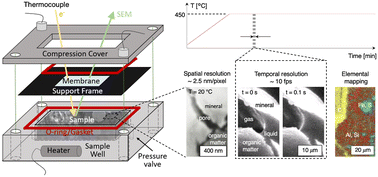Operando scanning electron microscopy platform for in situ imaging of fluid evolution in nanoporous shale†
Abstract
Fluid–solid interactions in nanoporous materials underlie processes fundamental to natural and engineered processes, including the thermochemical transformation of argillaceous materials during high-level nuclear waste disposal. Operando fluid–solid resolution at the nanoscale, however, is still not possible with existing optical and electron microscopy approaches that are constrained by the diffraction limit of light and by vacuum-fluid incompatibility, respectively. In this work, we develop an operando scanning electron microscopy (SEM) platform that enables the first direct in situ imaging of dynamic fluid–solid interactions in nanoporous materials with spatio-temporal-chemical resolutions of ∼2.5 nm per pixel and 10 fps, along with elemental distributions. Using this platform, we reveal necessary conditions for thermochemical pore and fracture generation in shales and measure their surface wetting characteristics that constrain the feasibility of high-level nuclear waste containment. Notably, we show that low heating-rate conditions typical of radioactive decay produce hydrocarbon liquids that wet fracture and pore surfaces in a self-sealing manner to impede aqueous radionuclide advection.

- This article is part of the themed collection: Lab on a Chip HOT Articles 2023


 Please wait while we load your content...
Please wait while we load your content...